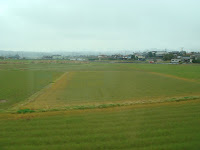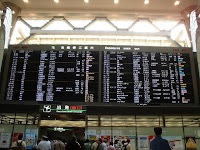
Since my work in Japan requires me to move all over the country, arrangements had to be made for me to stay in several hotels. I stayed at the
Shinjuku Washington Hotel when I was in Tokyo for the first four days. When I was in Kyoto, I stayed at the
Granvia Kyoto. During my duration of stay in Okayama,
Granvia Okayama became my base. In Osaka, the hotel that I stayed in was the
New Otani Osaka. Now that I am back in Tokyo, I am also back at the Shinjuku Washington Hotel. As my boss will be arriving this Sunday, I will be joining him at the
Imperial Hotel Tokyo until the end of my stay in Japan.
There are a few interesting observations that I have made with regards to hotels in Japan (at least, the ones that I stayed in).
The first thing that struck me is the availability of baggage transfer from hotel to hotel. This is especially handy if you are in Japan for a long stay, and that you have many pieces of luggage or that your luggage is bulky. Upon check out from one hotel, you can actually use this service to have your luggage sent to your next destination, even if your next destination is in another city or prefecture. For instance, when I checked out from the Shinjuku Washington Hotel, my luggage was sent to Granvia Okayama. I just brought along what I needed for my two-night stay at Gravia Kyoto. By the time, I arrived in Okayama, my luggage was already waiting for me in my room. This helps a lot as I was able to travel light.
Honestly speaking, I am not sure if such a service exist in Malaysia. Even if it does, I wonder how effective and efficient the service is. If this kind could be introduced in Malaysia (with similar efficiency and quality of service), I am sure it will serve as a value-added service to the hotel industry in particular and tourism in general.
The other thing that I find particularly interesting is that the majority of the porters (or bellboys) working in Japanese hotels are actually ladies. I have not seen female porters in Malaysia. In Japan, however, the reverse is actually true. It is difficult to find male porters. And one thing that I must add here is that the porters in Japan are true professionals. Not only do they bring you and your luggage to your room, they even explain all the facilities available in the room. This is especially useful because facilities from one hotel to another can greatly differ. As such, a short briefing by the porters is not only informative but also helpful. I remember that certain porters in Malaysia only expect tips as soon as they bring your luggage into your room.
Of course, not everything in Japanese hotels is perfect. One little complaint that I have is the lack of wireless Internet access in the hotels. None of the hotels that I have been to actually have wifi, which I find pretty odd. If you are sharing a room with another person, and both want to use the Internet, then you would have to take turns. On this aspect, I think the hotels in Malaysia are slightly more advanced. I have been to a three-star hotel in Malaysia that actually provide wireless Internet connection for its guests. Most hotels have wifi connection at their lobbies at the very least. Not here in Japan though.
Just my two cents worth. Or should it be, my two yen?
 It rained again today. The only item on my agenda for today was the dinner reception with the Prime Minister at the New Otani Hotel organised by Yayasan Pelajaran MARA. The Prime Minister had been in Tokyo for an official two-day visit to Japan.
It rained again today. The only item on my agenda for today was the dinner reception with the Prime Minister at the New Otani Hotel organised by Yayasan Pelajaran MARA. The Prime Minister had been in Tokyo for an official two-day visit to Japan. 




































